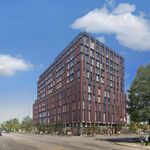FYI
www.nytimes.com/2006/11/2...ref=slogin
November 25, 2006
In Cincinnati, Life Breathes Anew in Riot-Scarred Area
By CHRISTOPHER MAAG
CINCINNATI — A few years ago, Jim Moll, a real estate agent, turned to his friend Bill Baum, a developer, and asked whether anyone would ever sell condominiums on Vine Street, the epicenter of race riots here in 2001.
“Not in our lifetimes,†Mr. Moll recalls Mr. Baum replying.
One recent afternoon, Mr. Baum, 57, stood on the battered pine floorboards of a 130-year-old building on Vine Street as a workman mixed cement in a wheelbarrow. Mr. Baum’s company, Urban Sites, is transforming this vacant brick shell into six condominiums, which he plans to sell by next summer.
“To hear the jackhammers and the booms and the nail guns,†Mr. Baum said, “it’s music to me.â€
Vine Street runs through the heart of Over-the-Rhine, a neighborhood of narrow streets and ornate brick buildings built by German immigrants from 1865 to the 1880s. After decades of decay in the area, gentrification is spreading north from downtown and south down the steep hillside of Mount Auburn. New condominiums, art galleries, theaters and cafes are bringing people and investment.
But poverty remains, as do drugs, violent crime and the stigma of the three days of riots in 2001. The riots effectively killed an earlier Over-the-Rhine renaissance, in the late 1990s.
The magic of Over-the-Rhine is in its compact brick buildings. Mostly two- to four-story walkups, few are significant individually. But together they create a historic district with a scale and grace reminiscent of Greenwich Village in New York. In May the National Trust for Historic Preservation listed the entire 362-acre neighborhood as one of the country’s 11 Most Endangered Historic Places.
As Over-the-Rhine’s white families left for the suburbs after World War II, its buildings attracted black families displaced when Interstate 75 tore through the nearby West End neighborhood, said Vice Mayor Jim Tarbell, who moved to Over-the-Rhine in 1971. It gradually became a slum in what the Census Bureau has found is the sixth most segregated city in the nation.
By 1990 the neighborhood’s median family income was $4,999, census figures show. It was the most dangerous part of the city, according to Police Department records, with almost 22,000 calls for emergency service, 8 murders and 306 robberies in 2001.
During the first renaissance, a generation of young hipsters discovered Over-the-Rhine, drawn by sturdy, funky and affordable buildings just a five-minute walk from downtown. The first nightclubs moved to the area in the 1980s, followed by art galleries and specialty shops. St. Theresa Textile Trove opened in 1994 and attracted art quilters from across the country, said Becky Hancock, its owner. A few doors down stood the Suzanna Terrill Gallery.
At the height of the boom, Mr. Baum said, young downtown office and restaurant workers placed down payments on future apartments that still had garbage piled on the floor and pigeons nesting in the walls.
“There was this palpable feeling that things were really taking off,†said Ran Mullins, who moved to the neighborhood in 1999 and now owns Metaphor Studios, an advertising agency in Over-the-Rhine.
But early in the morning of April 7, 2001, Stephen Roach, a white police officer, shot and killed Timothy Thomas, an unarmed African-American, after a foot chase. A protest march two days later devolved into riots. Many Over-the-Rhine businesses were looted.
After the riots, redevelopment projects fizzled. Most of the nightclubs closed. Demand for apartments dwindled, Mr. Baum said. Art galleries, including Suzanna Terrill’s, closed, and St. Teresa Textile Trove moved to another neighborhood because customers refused to drive into Over-the-Rhine.
“The riots set this neighborhood back a decade,†Mr. Mullins said.
Paradoxically, the riots’ reverberations may actually speed Over-the-Rhine’s recovery. Afterward, thousands of renters receiving federal rent subsidies left the neighborhood.
“A huge number of people just vamoosed,†said Marge Hammelrath, director of the Over-the-Rhine Foundation.
Their exodus left 500 of the neighborhood’s 1,200 buildings vacant, according to the Trust for Historic Preservation. Property values dropped, making it easier for developers to buy into the neighborhood.
But unlike the last boom, where small developers rehabilitated buildings one at a time, Over-the-Rhine’s current wave of gentrification is driven by Cincinnati’s corporate and philanthropic elite, whose strategy is to buy entire blocks. The largest player is the Cincinnati Center City Development Corporation, known locally as 3CDC, which was created in 2003 with $80 million raised by the city’s corporate leaders.
In the last 18 months, 3CDC invested $27 million in Over-the-Rhine, buying 100 buildings and 100 vacant lots, said the organization’s president, Stephen Leeper. It completed 28 new condominiums on Vine last year and is building 68 more.
Next came the Art Academy of Cincinnati, which spent $13 million to move from its hilltop campus into two adjacent warehouses in Over-the-Rhine last summer. Now the academy’s sign, which is four stories tall and reads “ART†in red neon letters, casts its light into new condominiums. The academy also became an anchor for smaller arts groups, like Know Theater of Cincinnati.
The neighborhood’s rapid growth makes some people worry that low-income families will be pushed out.
“Obviously the architecture is beautiful,†said Bonnie Neumeier, a community activist. “But we feel that the faces of our people are more important than the facades of the buildings.â€
This time, the biggest threat to revitalization may come less from crime or racial tension than from Over-the-Rhine’s buildings themselves. Many sat vacant for so long that they are on the verge of collapse, Mr. Tarbell said, and some that were used as crack dens were bulldozed.
“This is a race,†aid Bill Donabedian, a director at 3CDC. “If we don’t move quickly, we will lose these buildings forever.â€




























































